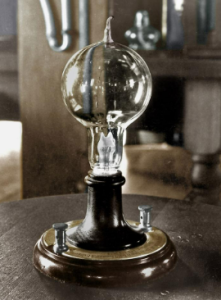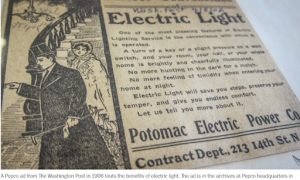 Joanna Kendig presented a free, virtual Preservation Café “Power and Light: the Story of Electricity on Capitol Hill,” Tuesday, March 26, 2024. The presentation was recorded.
Joanna Kendig presented a free, virtual Preservation Café “Power and Light: the Story of Electricity on Capitol Hill,” Tuesday, March 26, 2024. The presentation was recorded.
Due to technical difficulties a few minutes at the beginning of the presentation are missing, for which we apologize.
On March 26, Joanna Kendig, a local historian, and CHRS board member, treated Capitol Hill residents to an overview of the systems development and evolution of the electric services we often take for granted in our homes. It seems we only recently discovered how to harness electricity to serve humanity during the 19th century.
Kendig explored the private electrical enterprises that emerged in Washington during the late 1800s to serve our growing city. Companies, such as the Potomac Electric Power Company (PEPCO), U.S. Electric Lighting Company, Chesapeake and Potomac Telephone Company, and Columbia Light and Power Company, expanded, merged, and bought each other out as they created an electric distribution system to power our street lights and run our streetcars. Kendig continued into the 20th century as PEPCO, our utility company built power plants and substations across the city.
Electricity was first installed to light the city’s main street arteries in 1882. Washington ran its first electric trolly in 1888. An electric generator was installed in the White House basement in 1891.
The electric system was initially built to serve commercial uses – 16 percent of businesses had electricity by 1913. Next came the drive to light residential homes. Kendig found a 1906 newspaper advertisement in which PEPCO extolled the benefits of using electricity to light your house – it will “save you steps, preserve your temper, and give you endless comfort,” eliminating the need to hunt for matches!
Over the next decades, the city’s row houses gradually traded gas lights for electric light bulbs and coal stoves for electric ranges in wealthier areas. Manufacturers responded in kind by providing an increasingly wide range of small and large appliances that would become cheaper, larger, and more energy efficient.
PEPCO initially sold electric appliances directly to the consumer. The company established a home services department in 1925 and sent home economists to customer’s homes to demonstrate the possibilities – refrigerators, toasters, irons, vacuum cleaners, and washing machines!
Kendig jumped forward to the 21st century as Washington’s expanded electric grid and infrastructure continued to evolve. Fortunately, for Washingonians a good deal of this infrastructure is underground.
In 2018, the District passed the Clean Energy DC Omnibus Amendment Act which mandated we move away from fossil fuels to run 100 percent on clean energy by 2032. Interestingly, this has prompted many parts of our city to return to local centers of power generation.
For example, the Blue Plains Wastewater Treatment Plant is harvesting methane from human waste, Brentwood Reservoir captures solar energy with a large array of solar panels, and the Capitol Power Plant provides steam and chilled water to heat and cool buildings throughout the U.S. Capitol campus. Many residents have installed solar panels on the roofs of their houses to create individual power stations!
The city is slowly making and realizing plans to repurpose the remnants of the old power plants and substations throughout Capitol Hill – into residential units, restaurants, and mixed-use facilities. Examples include the PEPCO substations at 7th Street, SE, and 8th Streets, NW, Navy Yard Central Power, the Buzzard Point Power Plant and substation, and Building 170, a beautiful old spacious brick building many of us pass as we walk to Nats Stadium. The possibilities seem endless!

Capitol Power Plant 1910
Our CHRS Preservation Cafés are free to both CHRS members and non members.
